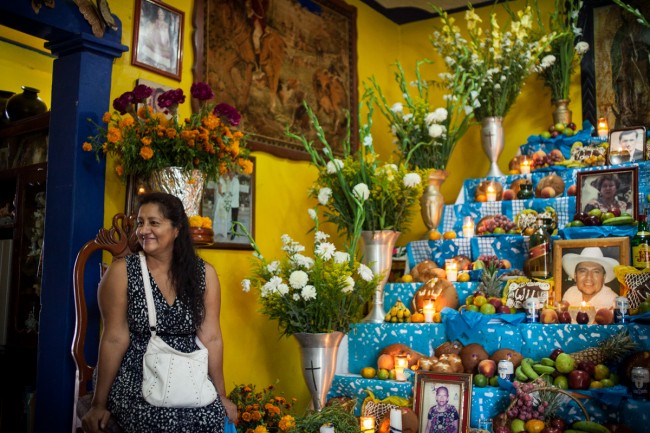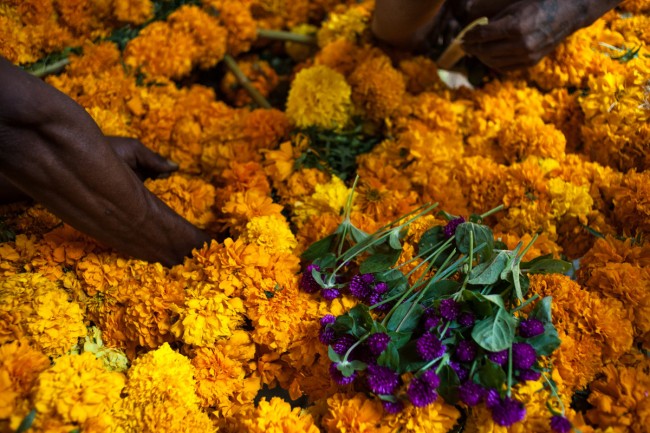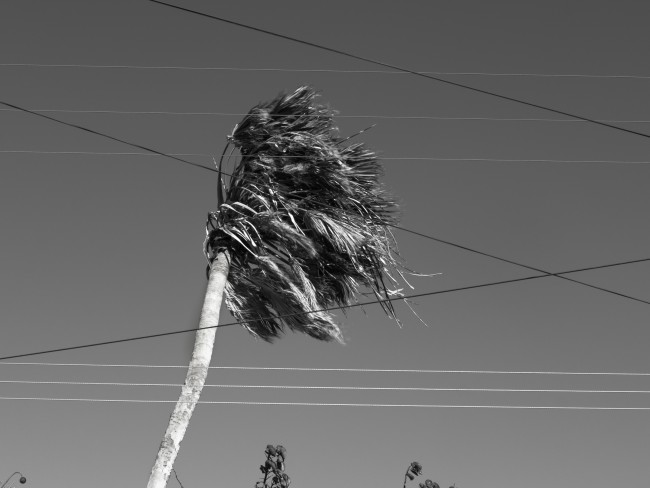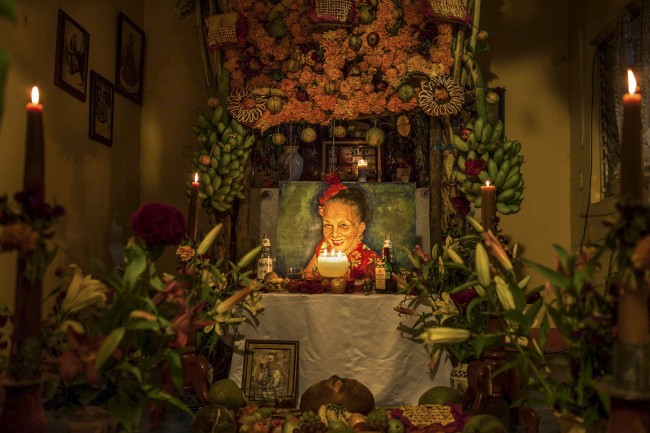My uncle’s name was Cesar. He was a singer and pretty well known around here. He died and was buried, and on the day before this Todos Santos, this Día de los Muertos, when I was in Mexico City, I dreamt that my uncle Cesar came to see me.
“Mi hijo, my son, I am lost,” he said. I looked at Cesar and told him not to worry, that I would take him back to Juchitán with me on the bus. When we got close, I pointed out the window, “Look, uncle, we are here.” We walked from the bus station downtown, and Cesar said to me, “I am so hungry.” So we sat down below the Municipal building where they sell garnachas, tlayudas, and tacos. “I am so hungry,” he said again, and I pushed my plate over to him, “Eat, uncle, eat.”
“Mi hijo, I don’t know where I live, will you take me to my house?” “Uncle, you live all the way in La Ventosa,” I said, but he asked again, “Please, take me.” We walked from downtown to the bus stop by the highway, where the buses leave to go to La Ventosa. Once Cesar had got on the bus, I told him I was going to get off. “Listen Cesar, when you get off the bus in La Ventosa, someone there will recognize you, and they will take you home.”
It was such a strange dream, so I called my mom up to tell her about it.
“Mi hijo, today is Cesar’s first Todos Santos,” she said. “Your cousins, you know they converted to Protestantism, and they never built an altar for your uncle on the first year after his death—they never did Xandú Yaa for him, they never placed candles out for him, there was nothing for him. Your uncle’s soul,” she hesitated, “is probably lost.”
My mom rushed off the phone, “Listen, I need to call your aunt. I have to tell her about your dream, so that they will put something out for him tonight.
— Gubidxa Guerrero, Centro Cultural Herón Ríos (November 1, 2014)
*****
A palpable change occurs in Juchitán in late October. Not only does the town celebrate Todos Santos (the Day of the Dead and referred to as Xandú in Zapotec), but on the Isthmus of Tehuantepec, the seasons also change. Gusiguié in Zapotec means “the season of flowers,” which lasts from April to October. The temperatures are warm, and bi nisa, a soft and feminine wind, arrives gently from the south. As the days pass from May into June, almost all Juchitecos will sweat their way from party to parade throughout this period of important fiestas. Then, come late July, the calendula begins—a forty-day crescendo leading up to the first rain. This subtle change in weather signals to farmers that they must sow their fields in order to prepare for what comes next—rain. When the brief period of rain does arrive, it does so in force. The rain then lets up midway through October, and a refreshing breeze sweeps through town. Starting off slow, the air quickly picks up speed. This wind, called bi yoxho in Zapotec is an “old grandfather”—a forceful wind from the North. This is when the season changes once again. October until April is the season of gusibá, or “the season of the tombs.”
Like most foreigners in Mexico for Día de los Muertos, I possessed a collage of images that defined my expectations for this holiday (Day of the Dead = dancing skeletons). However, what I experienced late in October 2014 was something I had to learn many times over during my fieldwork in Juchitán. My expectations were not only always wrong, but they were also constantly subverted to reveal their total futility.
I had come to Juchitán to conduct fieldwork regarding different experiences and perceptions of the massive industrial-scale wind energy industry that had emerged in recent years. So while I knew a little bit about the wind, I did not expect to find myself fascinated by the Day of the Dead. I didn’t know of any connection, nor did I think I was the best person to study that question. So what I am writing is rather unexpected.
Unlike the state-sanctioned Day of the Dead popularized across the globe, Xandú in Juchitán is a solemn occasion. Juchitecos invite their recently deceased relatives to visit. The souls will quite literally arrive. I had been attending a weekly Zapotec history class at a local community center since I arrived a few months earlier. Our professor was a young historian named Gubidxa, and the class size varied from between eight and ten adults, while neighborhood kids would wander in and out. Our discussion on November 1 was about Xandú, and Gubidxa was urging the other students to reflect on the “why” of their own family’s practices. After various aspects were mentioned, like the fruit that is laid out on the altar, Gubidxa sought to sum up their points to move the conversation forward. “Most of us here have a similar conception of death, especially when it comes to the days of Xandú. The souls of recently deceased relatives will come home. How they do it, who knows? But they are coming. And if they are coming, then we must have everything prepared to receive them, because if we are going to receive them, then we have to receive them properly, as they deserve.”
The elements and procedural details of Xandú, he explained, facilitate the soul’s journey of transformation. Our conversation then turned to some of the unspoken rules. “If someone died on October 20, you aren’t going to make an alter for the Day of the Dead on October 30, are you? No, you are going to wait until the next year. But why?” His enthusiasm started to mount: “Our grandparents have taught us that this is because the deceased won’t be able to make it back that quickly—they are still on their way. Where they going, who knows? But it’s going to take them a while to get there.”

While the essentials—like water, candles incense, flowers, fruit, and bread—are always displayed in abundance, people will also display chocolate, tamales, and “if they liked tlayudas, well, you can put those out too. If they preferred spaghetti, well then you put out spaghetti. The souls will draw out the essence of this food to nourish themselves.” The candles help illuminate the route to guide the soul home, the scents help in this as well. The glass of water—well of course they will be quite thirsty from their long journey.
Altars take one of two forms. The first, biguié or biyé, uses flowers, wood, and banana leaves to construct a square within which four smaller squares are then formed, all of which are then surrounded by a circle. This design is said to derive from the Zapotec calendar—a 260-day year with months that last twenty days. A woven mat is set in front of the biyé whereupon the fruit, candles, food, and water are displayed. From reading and conversations, it seems that the mat is one of the most important aspects of this altar, as it serves to separate space. Following the logic that the souls are quite literally coming, it is on the mat where the living and the dead meet. The other form of altar is like one face of a pyramid, constructed with nine levels, each said to represent one of the levels through which the soul must pass in their journey from this world to the other.
In the days before and after Xandú, I found myself kind of surprised by my interest in the details of ritual practice. I had come to study infrastructure and I thought of myself as a “real modern anthropologist,” blah blah blah. But there was something about it that just grabbed me—perhaps a reason so many anthropologists are drawn to Juchitán.
Everyone agreed—after Xandú, when the altar is dismantled, all of the fruit that has been left out, despite being only a few days old, has no flavor at all. My first instinct when my friends said that was skeptical. As the days passed and I kept talking about it with people, it finally hit me: the aspects of the altar are not merely symbolic—they are also very real. Ashamed by my own disenchantment, I tried to learn what the world felt like if the fruit really had no flavor.
In late October, between the change in season and the solemnity of Xandú, the overall feeling of the city was distinct, and in my memory, it stands out as a time apart from the rest of my fieldwork. Juchitán is normally a very loud place, a city that seems to be quite literally bursting from the seams with noise. But when writing this and recalling this period, the memories are uncharacteristically quiet, except, of course, for the music and the wind. While preparations in the days leading up to October 30 were, per normal, filled with lewd jokes, once evening came, it was conspicuously quiet. We sat on the patio outside the small room where the altar was built. The lights were mostly off, the wind howled, and the hundreds of candles struggled to remain alight.
I can imagine you might be reading this and thinking to yourself, obviously there is a connection between the arrival of the windy season and the arrival of the souls. I am just beginning to go through my field notes, listening back on the materials I gathered last year. I can’t say what it all means just yet. At the time, I was seized by the sensual—the flurry of preparations, the faint scent of copal smoke. But perhaps this convergence of seasonal change and ritual celebration underscores the ways the weather continues to manifest in actions and practices that are ancient but also in a constant state of change. This underscores so much of what I learned over and over again in Juchitán—there is a reason why and how things are done. It is not a logic I could have anticipated but, once experienced, is quite remarkable.
Juchitán itself is a convergence of intensities. The continuity from life to death is reflected in the annual climatic changes.
There seems to be a fortitude to these practices that I had not anticipated. The practices are simultaneously so very ancient and totally adaptive and ever changing. The word “syncretism,” so often used to describe the convergence of indigenous practice with the Catholic Church, just doesn’t seem to do it justice nor account for the ways practices change and adapt. What I observed and was taught by my friends in Juchitán was the complex, conflicted, and ever-shifting ways they grapple with their multiple ways of being in the world. My friends were cosmopolitan and at the same time committed to maintaining a set of practices that seems to help reinforce a very literal relationship to this very place. They are tied to Juchitán by practice—year in and year out. If their loved one’s souls are returning to the home where their umbilical cords were buried, then they must be there as well in order to welcome them as they deserve.
I like to think about these practices and try to embody these beliefs, imagining what it would feel like if my ancestors would come to visit. Not only would they come in October, but then, just as the winds start to slow down and the temperatures begin to rise once again, I would also be able to go to the cemetery, along with everyone else in town, to convivir—coexist—with my ancestors and neighbors for the equally important ritual on Palm Sunday in early April.
Stephanie Friede is a PhD Candidate in the department of Cultural Anthropology at Duke University in Durham, North Carolina. Her dissertation explores the culture and politics of industrial wind energy on the Isthmus of Tehuantepec in Oaxaca, Mexico.
All photos in this post are credited to the author.
Many thanks to my friends in Juchitán and the many scholars who have written about Zapotec relationships with death.
If you are interested in learning more about this place and practices:
De la Cruz, Victor. 2007. El pensamiento de los Binnigula’sa: cosmovision, religion y calendario con especial referencia a los binniza. Mexico City: Casa Juan Pablos.
Norget, Kristin. 1996. “Beauty and the Feast: Aesthetics and the Performance of Meaning in the Day of the Dead, Oaxaca, Mexico.” Journal of Latin American Lore 19: 53–64.
Nutini, Hugo. 1988. Todos Santos in Rural Tlaxcala: A Syncretic, Expressive, and Symbolic Analysis of the Cult of the Dead. Princeton, NJ: Princeton University Press.
Royce, Anya Peterson. 2012. Becoming an Ancestor: The Isthmus Zapotec Way of Death. Albany: State University of New York Press.
Cite as: Friede, Stephanie. 2015. “Weather, Ritual, and Día de los Muertos in Juchitán.” EnviroSociety. 30 October. www.envirosociety.org/2015/10/stephanie-friede-weather-ritual-and-dia-de-los-muertos.



